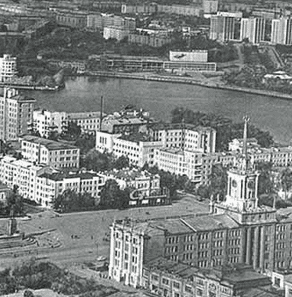Start date April 2, 1979 | ||
 | ||
Similar 1984 Rajneeshee bioterror, Tokyo subway sarin attack, Kyshtym disaster, Ufa train wreck, Moscow theater hostage c | ||
The Sverdlovsk anthrax leak was an incident in which spores of anthrax were accidentally released from the Sverdlovsk-19a military research facility on the southern edge of the city of Sverdlovsk (formerly, and now again, Yekaterinburg) on April 2, 1979. This accident is sometimes called "biological Chernobyl". The ensuing outbreak of the disease resulted in approximately 100 deaths, although the exact number of victims remains unknown. The cause of the outbreak had for years been denied by the Soviet Union, which blamed the deaths on intestinal exposure due to the consumption of tainted meat from the area, and subcutaneous exposure due to butchers handling the tainted meat. All medical records of the victims had been removed in order to avoid revelations of serious violations of the Biological Weapons Convention.
Contents
Background
The closed city of Sverdlovsk had been a major production center of the Soviet military-industrial complex since World War II. It produced tanks, nuclear rockets and other armaments. A major nuclear accident happened in this region in 1957, when a nuclear waste facility exploded (known as the Kyshtym disaster), resulting in the spread of radioactive dust over a thousand square kilometers. The biological weapons facility in Sverdlovsk was built after World War II, using documentation captured in Manchuria from the Japanese germ warfare program.
The strain of anthrax produced in Military Compound 19 near Sverdlovsk was the most powerful in the Soviet arsenal ("Anthrax 836"). It had been isolated as a result of another anthrax leak accident that happened in 1953 in the city of Kirov. A leak from a bacteriological facility contaminated the city sewer system. In 1956, biologist Vladimir Sizov found a more virulent strain in rodents captured in this area. This strain was planned to be used to arm warheads for the SS-18 ICBM, which would target American cities, among other targets.
The accident
The produced anthrax culture had to be dried to produce a fine powder for use as an aerosol. Large filters over the exhaust pipes were the only barriers between the anthrax dust and the outside environment. On the last Friday of March 1979, a technician removed a clogged filter while drying machines were temporarily turned off. He left a written notice, but his supervisor did not write this down in the logbook as he was supposed to do. The supervisor of the next shift did not find anything unusual in the logbook and turned the machines on. In a few hours, someone found that the filter was missing and reinstalled it. The incident was reported to military command, but local and city officials were not immediately informed. Boris Yeltsin, a local Communist Party official at this time, helped cover up the accident.
All workers of a ceramic plant across the street fell ill during the next few days. Almost all of them died in a week. The death toll was at least 105, but the exact number is unknown, as all hospital records and other evidence were destroyed by the KGB, according to former Biopreparat deputy director Ken Alibek.
The investigation
In the 1980s, there was vigorous international debate and speculation as to whether the outbreak was natural or an accidental exposure. If accidental, there was discussion of whether it represented violation of the 1972 Biological Weapons Convention. Various small investigations launched by Russian scientists in the years immediately following the dissolution of the Soviet Union re-opened the case in a number of newspaper articles.
A team of Western inspectors led by Professor Matthew Meselson of Harvard finally gained access to the region in 1992. Directly before they arrived they had been provided by the authorities with a list of 68 known incident victims in Sverdlovsk. By visiting and questioning in their homes surviving relatives of those who had died, the investigating researchers ascertained both where the victims had been living and where they had been during daylight hours at the time during which hospital admission records indicated a possible release into the atmosphere of anthrax dust. When the locations were plotted on maps, there was no very clear pattern defined by where the victims lived. However, there was a very precise indication from their reported locations during working hours, that all of the victims had been directly downwind at the time of the release of the spores via aerosol. Livestock in the area were also affected. It was revealed around this time that the accident was caused by the non-replacement of a filter on an exhaust at the facility, and though the problem was quickly rectified, it was too late to prevent a release. Had the winds been blowing in the direction of the city at that time, it could have resulted in the pathogen being spread to hundreds of thousands of people. The military facility remains closed for inspection. Professor Meselson's original contention for many years had been that the outbreak was a natural one and that the Soviet authorities were not lying when they disclaimed having an active offensive bio-warfare program, but the information uncovered in the investigation left no room for doubt. Meselson's wife, Jeanne Guillemin (who had participated in the investigation), detailed the events in a 1999 book "Anthrax: The Investigation of a Deadly Outbreak".
Aftermath
Russian Prime Minister Egor Gaidar issued a decree to begin demilitarization of Compound 19 in 1992. However, the facility continued its work. Not a single journalist has been allowed onto the premises since 1992. About 200 soldiers with Rottweiler dogs still patrol the complex. Classified activities were moved underground, and several new laboratories have been constructed and equipped to work with highly dangerous pathogens. One of their current subjects is reportedly Bacillus anthracis strain H-4. Its virulence and antibiotic resistance have been dramatically increased using genetic engineering.
